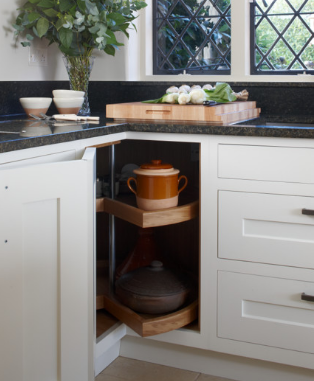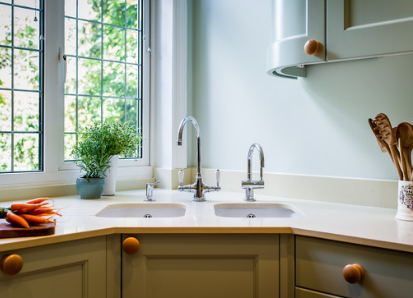In the planning of an L-shaped or U-shaped kitchen, the question often arises: what should I do with that corner cabinet? Corners can provide a lot of storage space, but they don’t always make items easily accessible. The juicer or bread maker you hid may never see the light of day again, just because you don’t want to fish it out of the depths of the corner cabinet. However, there are options that can help you get the most out of every corner of your kitchen. Here are some of the top solutions for kitchen corner cabinets.

1. Lazy Susans
Perhaps the most classic corner cabinet solution is the Lazy Susan (simple shelves that rotate in a circle to allow access to all sides). They come in two basic forms, a model like the one shown here, located inside a cabinet and rotating around a fixed center, with corner doors that open by a bi-fold hinge.
Note that this version has a cheese wheel shape and comes with a notch that fits the door when closed. These shelves are not 100% space-saving, but they are already very close, leaving only a little unused space in the corners. One disadvantage of this style is that each notch has to be rotated back into the correct position every time. Some may think it’s a small price to pay, while others will see it as a nuisance, so it ultimately comes down to personal preference.

In addition, models like this one do not have individual doors, but integrate them into the shelves so that the entire cabinet can be rotated open or closed at once. Just make sure it has a good mechanism to stop the door in the right place (usually with magnets or weights), otherwise it will always deviate slightly (and annoyingly).

You can also pair the Lazy Susan with angled corner cabinets to allow the entire circle to be placed in it instead of a cheese wheel shape. This particularly clever example uses an octagon instead of a circle to maximize the available space while still allowing it to easily align with the door.

2. Rotary and Pull-Out Shelves
Slightly different from the Lazy Susan concept, a rotating shelf like this one can actually be rotated out of the cabinet (rather than just inside the cabinet) to allow access to more shelves at once. They can still use the same cheese wheel shape on an inexpensive central swivel mechanism, which will allow the shelf to partially rotate out.

However, many modern systems allow the shelves to extend more fully, such as this example that allows the entire shelf to extend out of the cabinet (each shelf moves separately, so the bottom shelf is not covered by the top).
Weird, speckled shelves like this allow them to smoothly come out of the cabinet without hitting the sides or corners. This slightly reduces the square footage of shelf space, but makes it easier to scoop out medium-sized appliances such as blenders and blenders or cauldrons.

3. Advanced Pull-Out System
More advanced pull-out systems use multiple rectangular shelves that are connected by a complex set of hinges and rails, resulting in maximum shelf space and easy access.
Essentially, the first shelf pulls out along with the door and pulls the other shelf behind. This unit may cost a little more than others, but when square footage is valuable, it’s worth every inch to be able to really utilize your cabinet space.

4. Front Corner Cabinets
Kitchen-facing cabinets can come in two different shapes. One is a pentagonal shape that uses the entire corner. If the front of the pentagonal cabinet is wide enough, then the interior will be easy to access, although it will be a little difficult to see the interior corners from the outside. This can be a great place to store large, light items, such as flower pots, or seasonal items that don’t need to be taken out often.

For drawers, the pentagonal shape doesn’t work, so the inside of the available cabinet is still basically rectangular, but it slopes outward. In this case, some space is wasted around the drawer, but the drawer itself is easy to use and does not require complex pull-outs. Again, the trade-off depends on preference: you can reduce the storage area, but also the hassle.

Note: If it is an angled upper cabinet, it is best to match it with an angled lower cabinet. If you mix the sloping upper cabinet with the standard lower corner, the upper cabinet may protrude too far into your face to make it easy to use the lower counter. However, an angled lower body with a typical upper body works well and gives you a lot of breathing room.

5. Corner Drawer
Speaking of drawers, corner drawers like this peculiar set are another option worth considering. They can be pulled out directly and provide storage space at a 45-degree angle, but the front is arranged at a 90-degree angle for a clean look.

Depending on your counter material, angled tops can incur significant additional costs – for example, when using prefabricated rectangular counter boards made of stone or butcher blocks. Or it will take up too much valuable ground space, or it won’t fit around the island. But this drawer option can keep your counter in a basic L-shape while still getting convenient drawer space.
Corner drawers like these are great for storing small items that can fit at odd angles, making them a great place to store cookware, seasoning jars, and other small items.

6. Corner Food Pantry
Sometimes the best solution is to use corner space for full-height pantries instead of using many small drawers or drawers. This reduces counter space but gives you plenty of space to store dry goods.
The deeper and larger the cabinet, the easier it is to get inside, but it will take up more floor and counter space. If you have enough prep space on one side or island, losing a little counter space at one end of the kitchen may not negatively impact your workflow at all.

7. Corner Gallery Cabinet
If you prefer to store items such as plates and cutlery in corner cabinets, consider using glass inserts on both sides of the cabinet to make the contents of the cabinet visible. This will prevent you from losing items in the back corners of your eyes and create a nice gallery-like case-like feature.

8. Corner Shelves
Open shelving in some of the upper parts creates an attractive kitchen feature where you can keep lunch trays, breakfast bowls, recipe books and other everyday essentials within easy reach. Using shelves instead of corner cabinets allows you to avoid dark corners and frame your belongings to create an attractive display with architectural appeal.

This kitchen uses a large number of open shelves that are wrapped in corners to achieve a relaxed, open look while still maintaining a rustic décor scheme. Wooden floating shelves and light-coloured cabinetry bring freshness and natural warmth, balancing open storage for beautiful items and closed storage for other items.
9. Corner Desk
Instead of trying to use corner space for cabinets, maybe you should consider using it for something else entirely.

A table in the corner turns this hard-to-use space into fully usable legroom. If you need a place to do some small work or browse on your laptop, but don’t need a dedicated home office, a corner of the kitchen can provide just the right amount of desk space.
Using a stool instead of a chair allows you to fully stow the chair so that you don’t run into any obstacles when you’re in chef mode. Open storage baskets on shelves likewise make it easy to organize things like bills and supplies, and hide them when they don’t need them.
10. Corner Sink
If you can connect the pipes to the area, then a corner sink can be a practical and aesthetically pleasing use for a kitchen corner.

This arrangement provides some extra space around the sink, and the back corner is the perfect place to place essentials like dishwashing supplies or appealing features like flower pots. In addition, the back corners inside the cabinet can accommodate the pipes, so the area is not wasted.
Combine this with two windows that offer a beautiful view, and you get the ideal solution for the “blind” corner.

11. Empty Corners
Here’s the last thought: sometimes, it’s better to leave nothing in a tight corner. In a small kitchen, leaving a little breathing space in the upper can make the kitchen look more spacious. Plus, when you’re working at the counter, you’ll feel less claustrophobic if the heavy cabinets that are close to you aren’t as heavy. If you can eliminate some unnecessary items and clutter in your life, you may not miss out on extra storage space at all.


